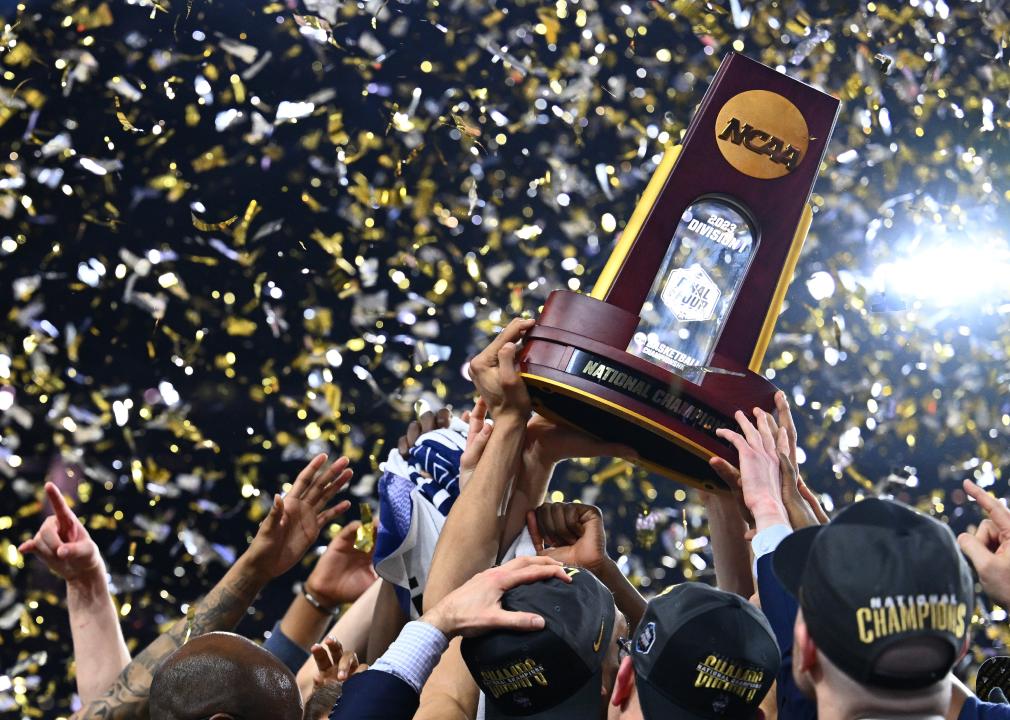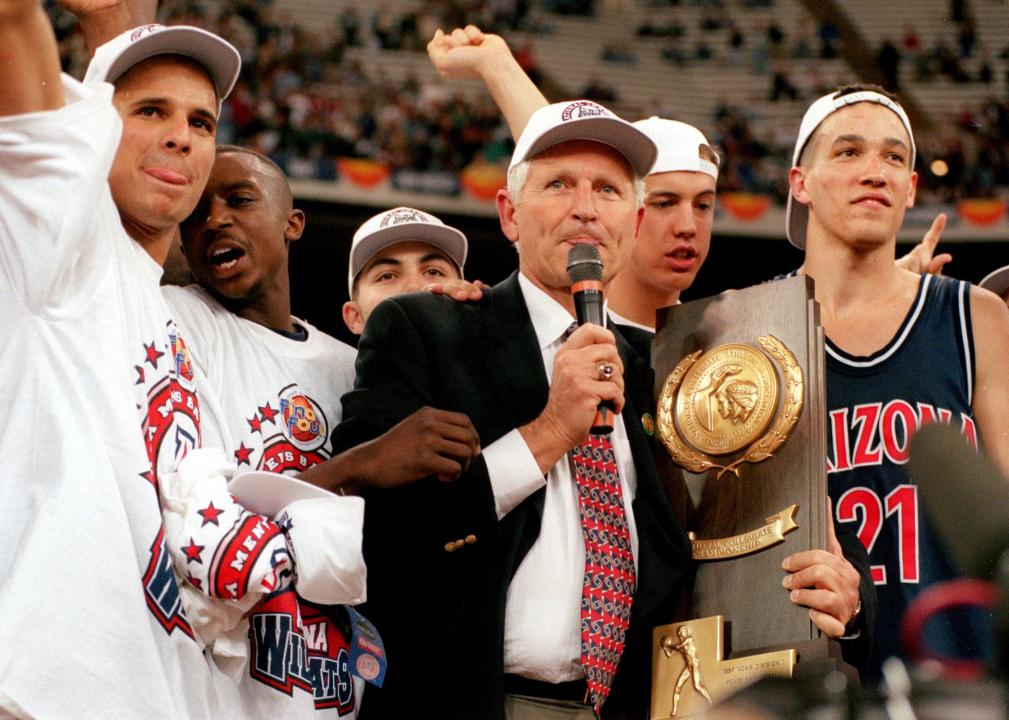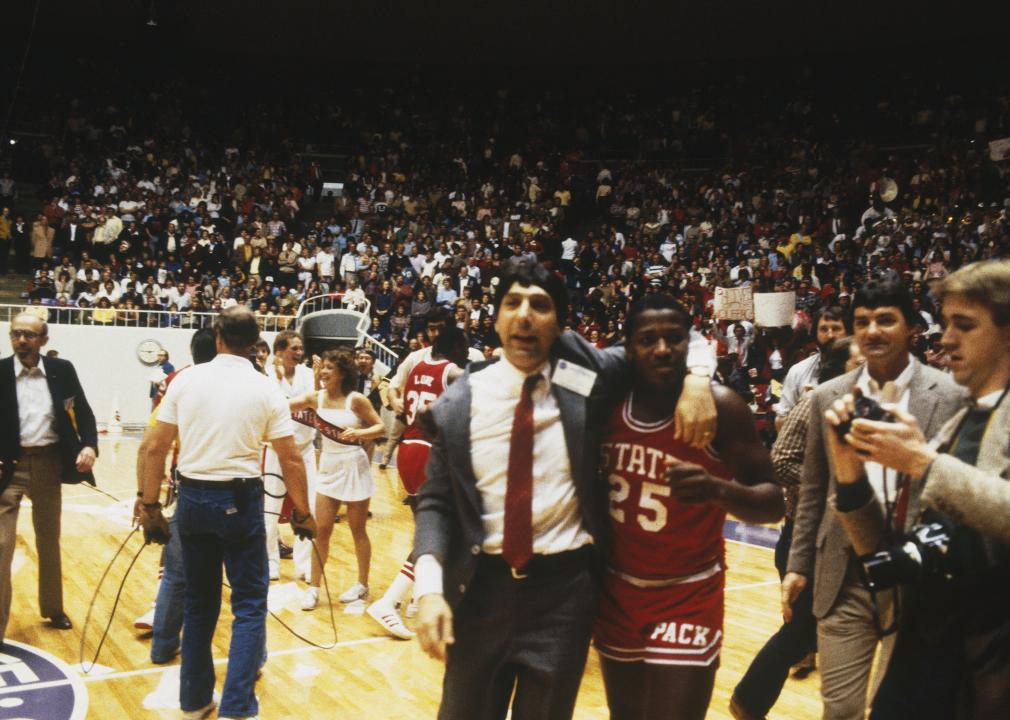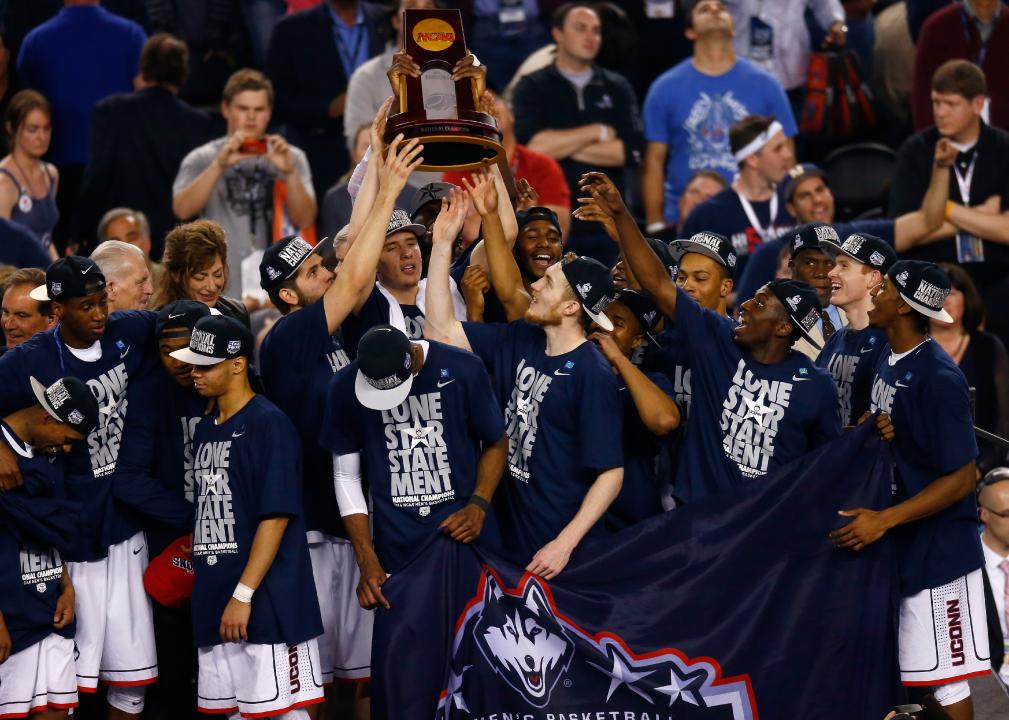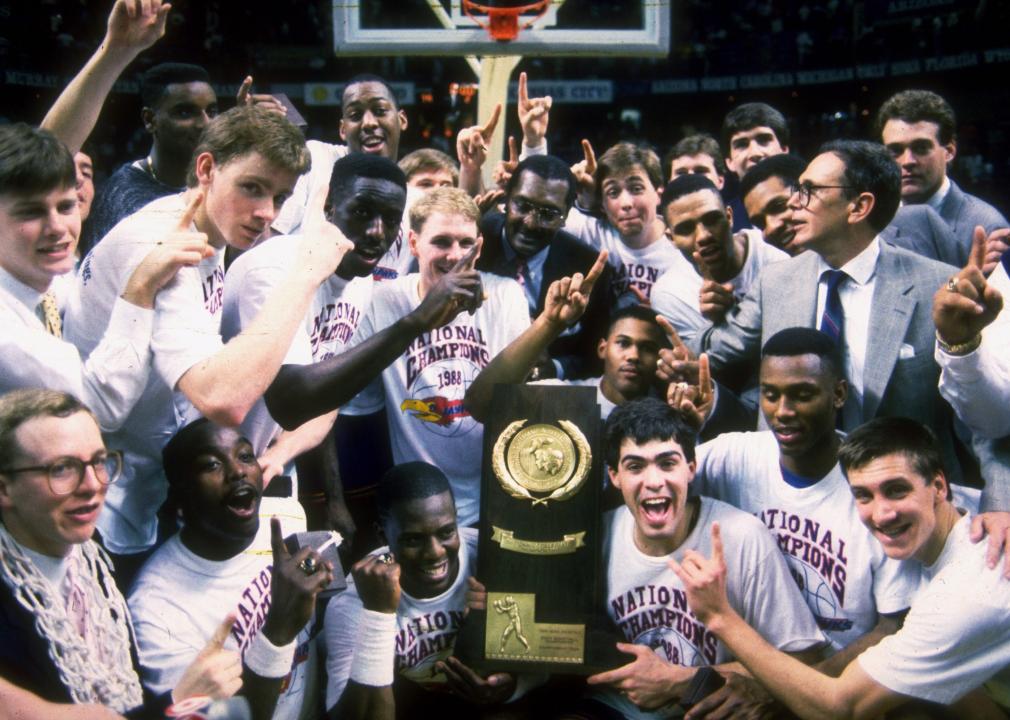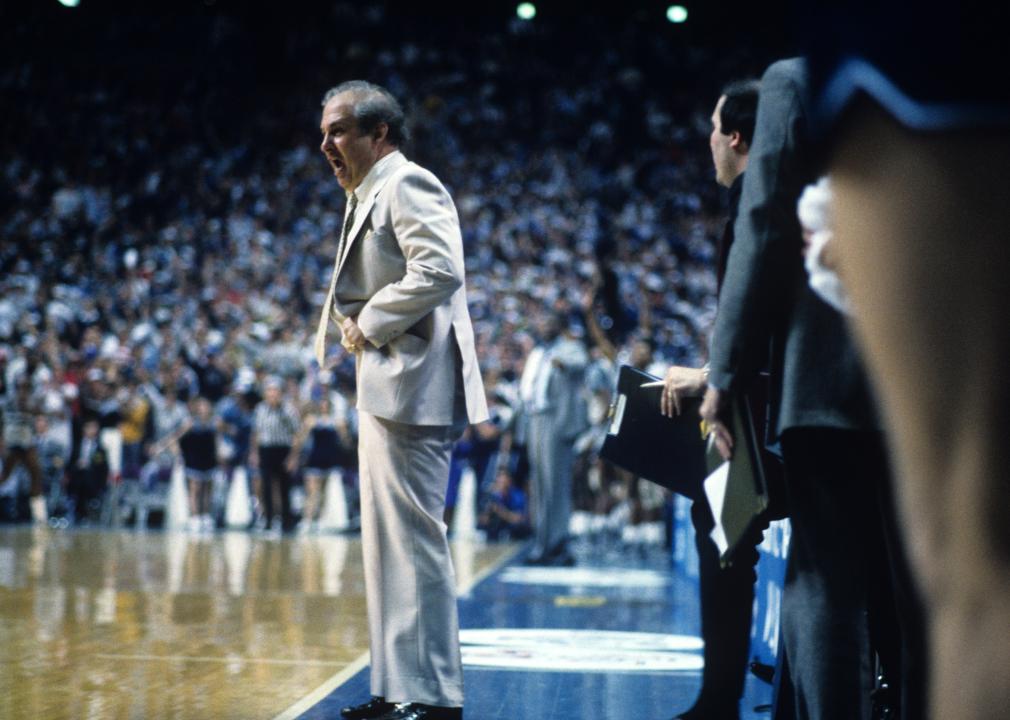Most surprising March Madness winners of all time
Brett Wilhelm/NCAA Photos // Getty Images
Most surprising March Madness winners of all time
The Connecticut Huskies celebrate with the NCAA National Championship trophy.
There’s a reason it’s called March Madness.
Besides the mad enthusiasm (and heavy betting) of partisan fans, the madness of underdog teams posting upset after upset to advance as far as the Final Four or even the championship game makes for compelling theater. Who doesn’t love an underdog or, in March Madness parlance, a Cinderella?
ATS.io compiled a ranking of the most surprising men’s March Madness champions since 1982 (when “March Madness” was coined) using Sports Reference data. Each team was ranked according to their lowest position in the final Associated Press poll conducted before that season’s March Madness. Ties were broken using Sports Reference’s Simple Rating System.
“Blue blood” teams—the elite of the elite, including Connecticut, Duke, Kansas, Kentucky, North Carolina, and Villanova—routinely land near the top of the AP and SRS rankings. The AP poll, updated weekly, is an ordered list of 25 teams based on the opinions of sports media, while the SRS combines average point differential and strength of schedule.
During March Madness, viewers relish watching blue bloods lose to unheralded teams, which are often programs with small student bodies and recruiting budgets. It happens surprisingly often, much to the delight of fans. The exception, of course, is when a blue blood alma mater loses to a Cinderella. That really makes a fan’s blue blood boil.
![]()
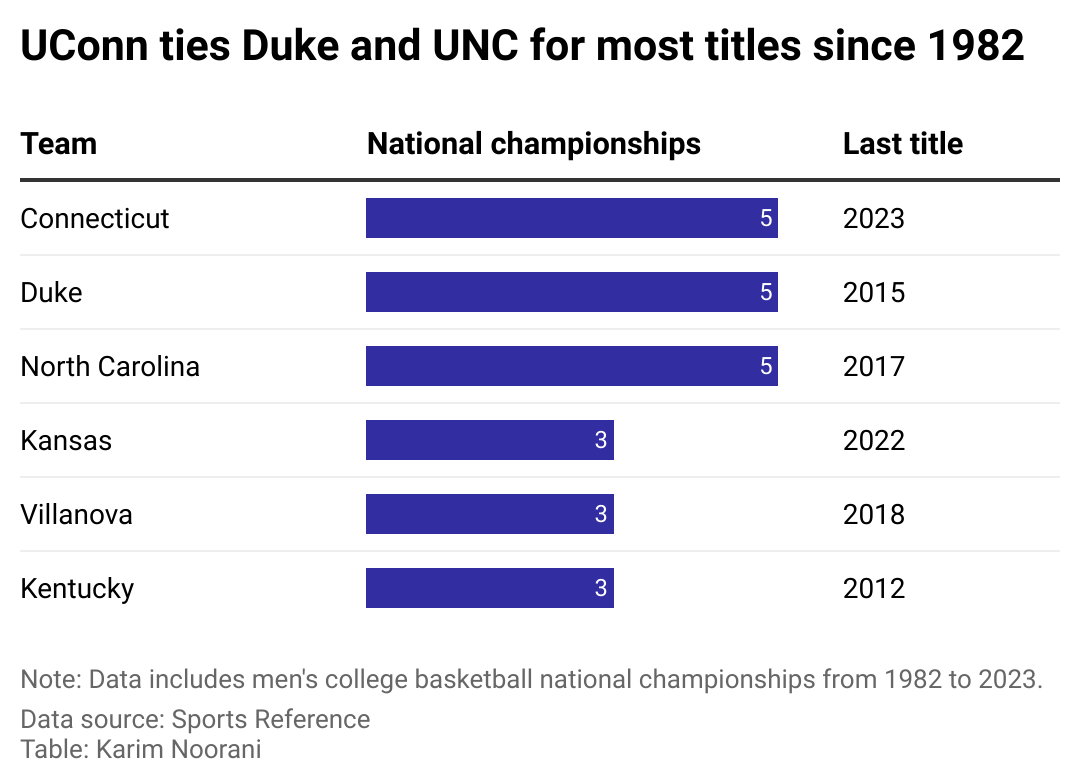
ATS.io
6 teams account for 24 of the last 41 NCAA championships
A chart showing the teams with the most national championsips since 1983
Fans and journalists revere blue blood teams because they routinely post excellent regular-season records and are almost always in the mix to win the national title. While the chart above shows the winningest men’s programs since the 1981-82 season, Indiana, Michigan State, and the University of California, Los Angeles, are also regarded as blue bloods by some because of their histories of success.
As you can see, six teams account for much more than half of all the titles won in the last four-plus decades—and curiously, two are located only 10 miles apart (Duke and North Carolina). The Blue Devils (in 1991 and 1992) are the only team on this list to win back-to-back titles since 1982 (Florida also did it in 2006 and 2007), though Kentucky came within one game of a threepeat from 1996 to 1998.
NCAA Photos // Getty Images
#5. University of Arizona, 1996-97
University of Arizona coach Lute Olson addresses the crowd while holding the 1997 NCAA Championship trophy.
– Final AP poll rank: 15
– Record: 25-9
– SRS rating: 21.66
With only two of the six leading blue bloods not on the East Coast (Kansas and Kentucky), it’s no wonder fans of those programs don’t think much of teams from the West. When the University of Arizona Wildcats clawed their way to the Sweet Sixteen in 1997, most figured they were overachievers doomed to cough up a furball. Arizona had finished just fifth in the Pac-10, but it was led by legendary coach Lute Olson and five players who went to the NBA.
The fourth-seeded Cats improbably upset three #1 seeds to take the title. After an 85-82 shocker against powerhouse Kansas, they won an overtime squeaker against Providence and eliminated North Carolina. Arizona won the championship over defending champion Kentucky (who also won the following season) 84-79 in overtime, and Miles Simon was named Most Outstanding Player following his second 30-point game of the tournament.
Focus on Sport // Getty Images
#4. North Carolina State University, 1982-83
Head coach Jim Valvano of the North Carolina State Wolfpack walks off the court with a player after winning.
– Final AP poll rank: 16
– Record: 26-10
– SRS rating: 15.26
It took a furious comeback in the championship game for North Carolina State to topple Houston. The Wolfpack needed six straight points to tie it and then a dunk before the buzzer by Lorenzo Charles over future NBA superstar Hakeem Olajuwon to win it—one of the maddest moments in March Madness history.
NC State nearly turned the ball over twice in the final 12 seconds, and Dereck Whittenburg was 27 feet from the hoop when he launched the desperate shot that fell short but right to a wide-open Charles, who grabbed it and stuffed it home.
It was all possible only because sixth-seeded NC State had upended three other tournament opponents in one- or two-point games, including first-seeded Virginia in the regional final. Legendary coach Jim Valvano, nicknamed “Jimmy V,” was no less enthusiastic than his players and fans in a wild postgame celebration of the first Cinderella to win the tourney, the “Cardiac Pack.”
Tom Pennington // Getty Images
#3. University of Connecticut, 2013-14
The Connecticut Huskies with the trophy after winning the NCAA Men’s Final Four Championship.
– Final AP poll rank: 18
– Record: 32-8
– SRS rating: 17.23
Considering UConn is tied for the most national titles since the 1981-82 season, it’s counterintuitive that their 2013-14 triumph was a big surprise. But the Huskies didn’t play close to the level of most of their other championship squads during the regular season. Half of their eight losses came to unranked teams, and they were drubbed 81-48 at Louisville, in the final game of the regular season.
Connecticut turned it on during March Madness, however. The Huskies, seeded seventh, beat four higher-seeded teams (Villanova, Iowa State, Michigan State, and then first-seeded Florida) to reach the national final against another Cinderella blue blood, eighth-seeded Kentucky. They never trailed in a 60-54 victory.
Shabazz Napier led the way with 22 points, winning the tournament’s Most Outstanding Player award. It was a remarkable run for a team that had been banned from March Madness the year prior because it failed to meet academic standards.
Rich Clarkson/NCAA Photos // Getty Images
#2. University of Kansas, 1987-88
Kansas celebrates its victory at the Final Four basketball championship.
– Final AP poll rank: Outside the top 20
– Record: 27-11
– SRS rating: 15.71
The sixth-seeded Jayhawks knew they weren’t in Kansas anymore when they faced second-seeded Duke in the Final Four and then first-seeded Oklahoma in the national final. But at least they didn’t have to venture far from the Sunflower State—both games were played just across the border in Kansas City, Missouri.
The Jayhawks almost didn’t make it that far. Their three final March Madness opponents had beaten them five times before the tournament started. The Jayhawks, however, initiated a revenge tour with a victory against rival Kansas State and then sealed the deal with a 66-59 win over the Blue Devils and an 83-79 nail-biter over the Sooners.
Credit the turnaround to Larry Brown, who later became the only coach to win an NCAA title and an NBA championship (Detroit Pistons, 2003-04). Kansas’ on-court contingent, led by national player of the year Danny Manning, was nicknamed “Danny and the Miracles” and still holds the record for most losses by a championship team.
James Drake // Getty Images
#1. Villanova University, 1984-85
Coach Rollie Massimino of the Wildcats looks on during the Championship game.
– Final AP poll rank: Outside the top 20
– Record: 25-10
– SRS rating: 12.03
The beauty of college basketball is that five good players are all you need to excel, so a hefty athletic department budget and a huge student body aren’t prerequisites. Still, nobody thought Villanova—with their 10 losses, including four to unranked teams in the regular season—would go far during March Madness in 1985.
The Wildcats didn’t just go far—they edged #1-ranked Georgetown 66-64 in one of the biggest upsets in sports history to claim the national title. The Hoyas, led by Patrick Ewing and four other future NBA players, were the defending champions, had mostly steamrolled their first five opponents, and had also beaten Villanova twice in Big East play, though the games were close.
Villanova’s triumph was sparked by the confidence of coach Rollie Massimino, and the Wildcats remain the lowest seed at #8 to ever win the title. Ed Pinckney, who went on to play for seven NBA teams over 12 seasons, was named Most Outstanding Player.
Story editing by Mike Taylor. Copy editing by Paris Close. Photo selection by Clarese Moller.
This story originally appeared on ATS.io and was produced and
distributed in partnership with Stacker Studio.
